Making Invisible Histories Visible
Page Navigation
- Making Invisible Histories Visible
- Lesson Plans and Resources
- iBooks on Omaha and Nebraska History for Primary Students
- Omaha Mapping Projects
-
African American Histories
- African American Artists
- African American Athletes & Facilities
- African American Churches
- African American Civil Rights Organizations - 1950s-1960s
- African American Civil Rights
- African American Contributions to Jazz, Gospel, Hip-Hop
- African American Dramatic Arts
- African American Education - Dorothy Eure & Lerlean Johnson
- African American Educators & Education
- African American Firefighters
- African American Homesteaders
- African American Law Enforcement
- African American Migration to Omaha
- African American Musicians of Omaha
- African American Newspapers
- African American Owned Businesses
- African American Politicians
- African American Social Life
- African American Workers at Omaha's Railroads & Stockyards
- African American Workers at the Naval Ammunition Depot in Hastings
- African Americans in the Civil War
- African Americans in Vietnam
- Charles B. Washington - Journalist and Civil Rights Leader
- Elizabeth Davis Pittman - Lawyer/Judge
- Green Book Omaha
- Marlin Briscoe - Professional Football Player
- Native Omaha Days
- Nebraska's Role in the Underground Railroad
- Sen. Edward Danner - Politician & Civil Rights Activist
- Sudanese Refugees
- Tuskegee Airmen
- European and Asian Immigrant Histories
-
Historic Neighborhoods & Buildings
- 24th and Binney/Wirt/Spencer Streets
- 24th and Lake Streets
- Central Park Neighborhood - 42nd and Grand Avenue
- Dahlman Neighborhood - 10th and Hickory Streets
- Hartman Addition Neighborhood - 16th and Williams Streets
- Indian Hills/Southside Terrace Neighborhood - 30th and Q Streets
- Jefferson Square Neighborhood - 16th and Chicago Streets
- Long Neighborhood - 24th and Clark Streets
- Orchard Hill Neighborhood - 40th and Hamilton Streets
- Smithfield Neighborhood - 24th and Ames Avenue
- St. Mary's Neighborhood - 30th and Q Streets
- Latino Histories
- Music Histories
-
Native American Histories
- Black Elk and John G. Niehardt
- Chief Standing Bear and Susette La Flesche Tibbles
- Dr. Susan LaFlesche Picotte - Native American Doctor
- Native American Education and Boarding Schools
- Native Americans in the Military
- Pre-statehood Interaction of Native Americans and Europeans
- Preserving Native American Tradition
- Restoring the Ponca Tribe
- The American Indian Movement in the 1960s and 1970s
- The Indian Congress at the 1898 Trans-Mississippi Exposition
- The Omaha Native American Indian Tribe
- OPS Elementary School History
- Redlining in Omaha
- Nebraska's Role in the Underground Railroad
- The 1898 Trans-Mississippi Exposition
African American Owned Businesses
-
What were some of the numerous purposes Black-owned businesses served in the North Omaha community, and how did they change over time?
Unity in the Community
-
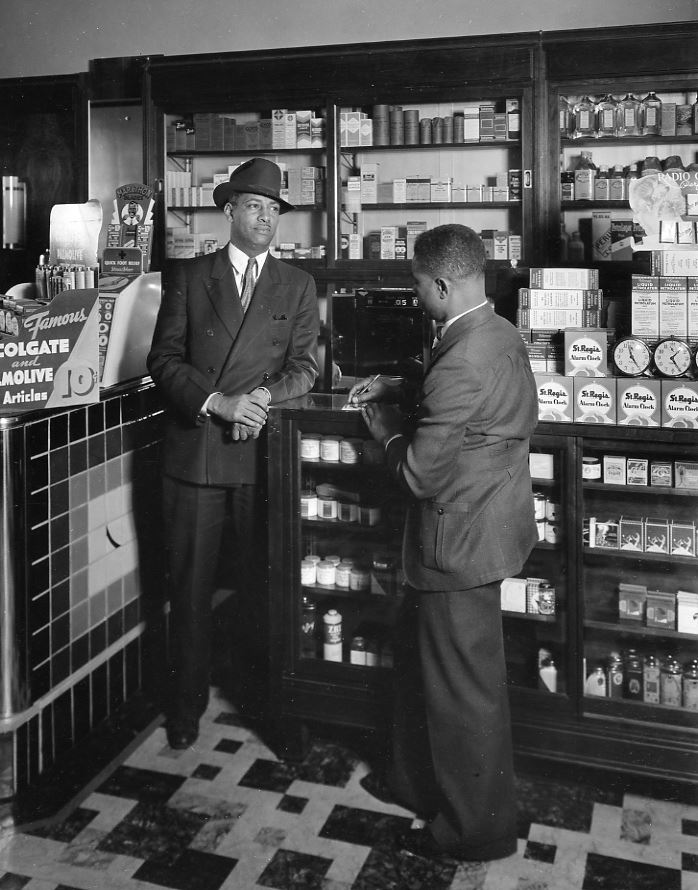
Robins Drug store at 2306 N. 24th St. in 1936. (The Durham Museum Archive Photo)
Black-Owned Businesses
-
Have you ever walked up North 24th Street and wondered about the history behind it? During the 1930s, North 24th Street transitioned from a predominantly Jewish community to a largely African American neighborhood. During the 1930s, there were several local African American-owned businesses, such as Myers Funeral Home , Robins Drug, and Harris Grocery Store. During the civil rights movement of the 1950s and '60s, several African American-owned restaurants opened and became significant community centers, such as Skeets Barbecue and Time Out Chicken, where we did our oral history. Civil rights activists gathered at the Fair Deal Café.
But the riots of the civil rights movement caused many thriving businesses to be burned. In 2011, with the growth of North Downtown, North Omaha has a chance to get back on its feet. Several businesses have taken over as important community institutions and social centers, such as Youngblood's Barber Shop, Nared's Peewee Palace, and Thomas Funeral Home. Many people believe that North Omaha will pick up again, including one businesswoman, Diane Mercer of Time Out Chicken. We agree because of the growth of North Downtown, the new stadium, and the proximity to the North Omaha business district.
A 4:22 interview in 2011 with Diane Mercer of Time Out Chicken about the history of the place. “The Big Bob” on the Timeout menu was named after Bob Boozer and Bob Gibson. In 1932, there were 94 Black-owned businesses. Average length of a Black-owned business: two years.
Harris Grocery Store
-
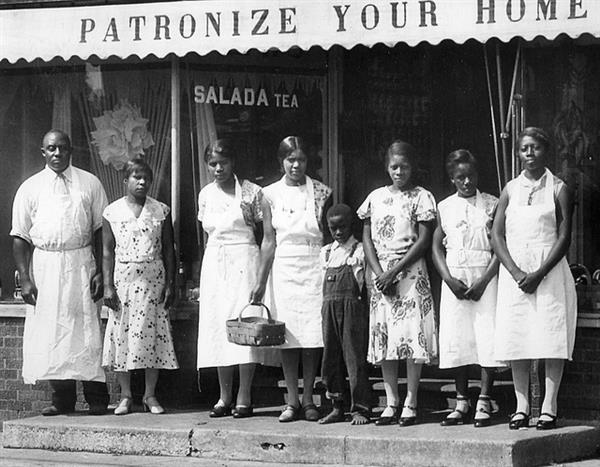
The Harris Grocery Store at 5306 S. 30 St. in 1930. (The Durham Museum Archive Photo)
Myers Funeral Home
-
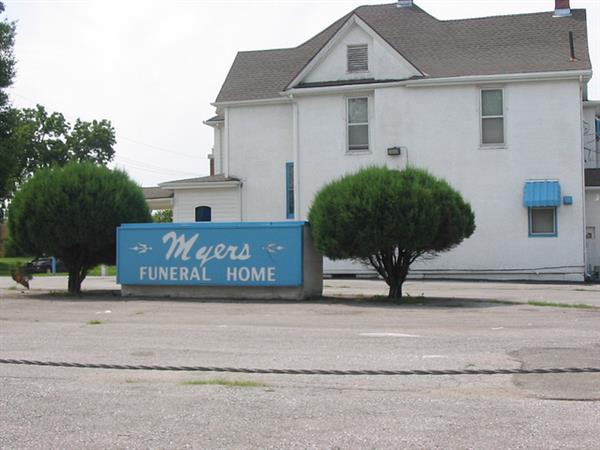
Myers Funeral Home has been a part of North Omaha's business community for 90 years before closing its doors in 2011. Larry Myers was the third generation of directors from the same family. This is significant because it is unusual for a business to be a part of a family for that long. Myers has also been in the same location, 22nd and Lake Street, for the whole 90 years.
Charles Hall
-
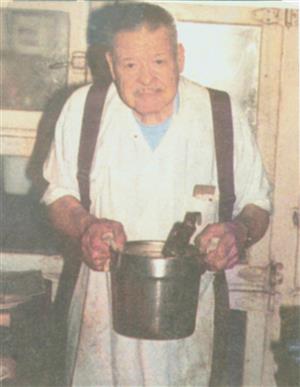 Charles Hall opened the Fair Deal Cafe in 1953. It's a place where you can get a "square meal for a fair deal." During the 1960s, it also served as a meeting place for activists in the civil rights movement. This is significant because it promoted unity in the African American community. (Photo courtesy of the Omaha World-Herald (Feb. 2001) and the Douglas County Historical Society)
Charles Hall opened the Fair Deal Cafe in 1953. It's a place where you can get a "square meal for a fair deal." During the 1960s, it also served as a meeting place for activists in the civil rights movement. This is significant because it promoted unity in the African American community. (Photo courtesy of the Omaha World-Herald (Feb. 2001) and the Douglas County Historical Society)
Time Out Take Out Chicken
-
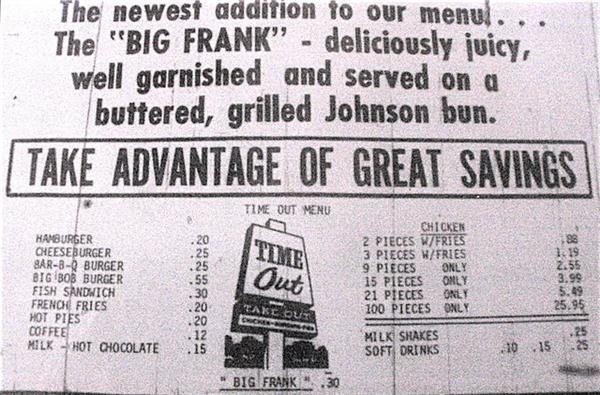
This picture is of the Time Out Take Out Chicken menu circa 1969. The prices on this menu are a lot cheaper than present-day prices at Time Out Chicken. The top part of the menu is an advertisement for the new "Big Frank" hot dog. The Big Bob Burger, named after professional sports stars Bob Boozer and Bob Gibson, had already been established. This menu is from around the time Diane Mercer's parents purchased the restaurant. Time Out Chicken has been at 30th and Evans, in North Omaha, for 43 years. It has had some competition from other fried chicken restaurants but continues to do well. During the past years, it has been passed down from Mercer's parents to her and her brother, who currently run the restaurant.
Youngblood's Barber Shop
-
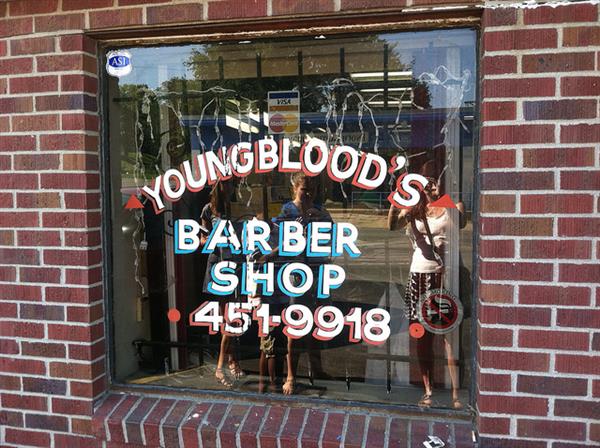
Youngblood's opened in 1977 at 40th and Ames.
Nared's Pee Wee Palace
-

Nared's Pee Wee Palace Day Care, on 36th and Crown Point. The daycare opened in 1979.
Additional Information
-
Courtney, Julianna, and Jaylen trace the history of African American-owned businesses from the 1930s to the present day, even though the first Black migrants arrived in Nebraska from southern states as early as the 1850s. Businesses owned by urban African Americans began to crop up along and near North 24th Street after 1920 when residential segregation created a clearly-defined African American neighborhood, and many white employers’ discriminatory policies made it difficult for Blacks to hold lasting jobs. Segregation created a market for neighborhood family businesses, and “encouraged a distinct and flourishing black culture on Omaha’s Near North Side” (Ashley Howard).
In October 1932, there were 94 individual businesses, formal and informal, conducted by African Americans, including drug and grocery stores, tailors, gas stations, “expressmen,” restaurants, barbershops and beauty parlors, newspapers, taxi services, real estate agencies, and undertakers. This long list gives the impression of great success in the nascent Black business community, but the average lifespan of a Black-owned business during that time was two years, the exception being the Myers Funeral Home, which had already been in business 12 years at the time of the 1932 study and survived until early 2011.
The author of the study listed several reasons that it was difficult for blacks in the 1930s to begin and maintain businesses, a prominent one being the lack of capital and difficulty in securing loans. When the students interviewed Diane Mercer of Time Out Chicken, she informed them that lending was the main challenge for her business in 1972, 40 years later.
This is where the students pick up the story, explaining the decline of the Near North Side because of race riots that caused many buildings to be burned throughout the Near North Side, but especially along North 24th Street in the 1960s. North Omaha experienced its years of glory in the early 20th century, and it can rise out of the aftermath of the turbulent 1960s into a strong business community and neighborhood.
2011 MIHV Project
Student Reflections
-
"My image of North Omaha has changed dramatically. It isn't just a place where crimes and killings happen; it's a place that was vibrant and alive. I believe it can get back to that. With this website and word of mouth, we can change North Omaha for the better."
- Julianna C.
"My understanding of the North Omaha neighborhood and Omaha's African American history has changed because now I feel closer to this area. I have gotten firsthand information from a businesswoman, and now I think about how 24th Street used to be, more than how it is now. 24th Street used to be lively and full of excitement, a fun community where everyone felt they belonged. Because many people moved away, this area faced some struggles, but I truly believe that it can return to what it used to be."- Courtney K.
"I used to see North 24th Street as just a regular street, but now that I have done this camp, I think of N. 24th St. as a very important part of Omaha. This camp has changed my view of things drastically; I now wonder how much history is still hidden. I would like to see a revitalization of N. 24th St., and I believe that one day it will change."- Jaylen F.
Resources
-
Howard, Ashley M. "Then the Burning Began: Omaha, Riots, and the Growth of Black Radicalism 1966–1969." Master's thesis, University of Nebraska at Omaha, 2006.
Landmarks Heritage Preservation Commission. "Chapter II: A Brief History of North Omaha." In Patterns on the Landscape: Heritage Conservation in North Omaha, 6-65. Omaha, NE: The Comission, 1984.
Sullenger, T. Earl and Harvey Kerns. Industrial and Business Life of Negroes in Omaha. Omaha, NE: Municipal University of Omaha and Urban League, 1932.
Workers of the Writers’ Program, Works Progress Administration (WPA), Nebraska. The Negroes of Nebraska. Lincoln, NE: Woodruff Printing Company, 1940.
Research compiled by: Courtney K., Julianna C., Jaylen F.

